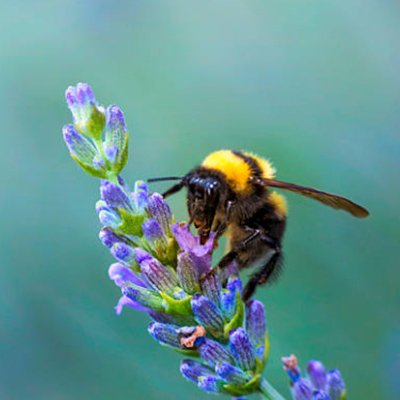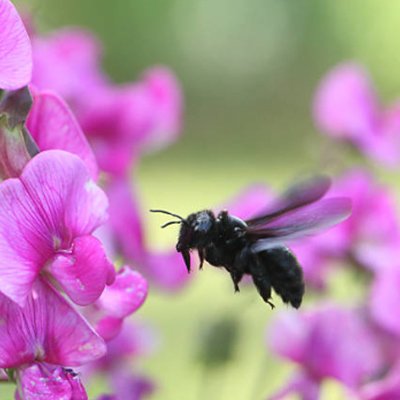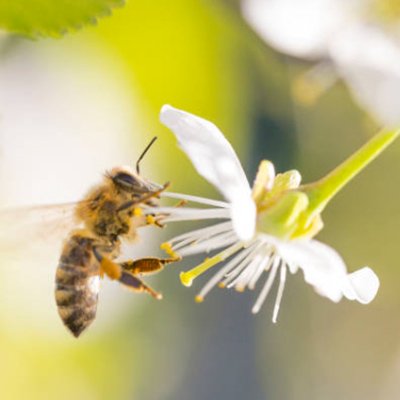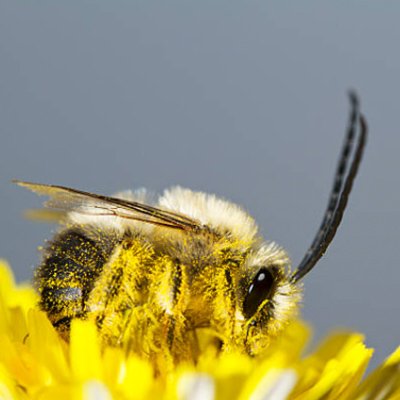Bees are extremely important to us humans and for the entire ecosystem to function. With bees pollinating a third of our food, we simply can not survive without them. However, these little, powerful creatures sometimes nest in inconvenient or even dangerous locations.We need bees, but we don't need them building hives inside of our walls or near where children play! Thankfully, there are ways to get rid of bees that won't harm them. Below, we'll describe how to get rid of bees safely, naturally, and permanently.
Identifying Different Types Of Bees
Not all bees are the same, and each bee has different behaviors and habits. Knowing what kind of bees you're dealing with will help determine how to get rid of them.
Bumble Bees

Bumble bees or known as "ground bees", these flying teddy bears are typically non-aggressive. They pollinate plants by vibrating on them and getting pollen stuck all over their hairy bodies. They are more likely to build hives in dry areas.
Carpenter Bees

These bees look similar to bumblebees, but their abdomens are a solid black rather than striped. The carpenter bee will usually nest in wood - ideally a tree, but you'll sometimes find them in decks or walls. They'll do quite a bit of damage as they build their nest.
Honey Bees

There are many types of honey bees. While Africanized honey bees are rather aggressive, honeybees typically will not sting you unless they are desperate. When a honey bee stings you, the stinger stays attached to you and rips away from the bee, resulting in killing it. Honey bees are one of the social bee species, and a caste system organizes their hives into worker bees, drones (male bees), and queen bees.
Mason Bees

Unlike other bee species, which collect pollen with their hind legs, the mason bee uses its hair from its abdominal scopa. Mason bees are not known to be stingers, and they are not social bees and do not have a hive or a queen to protect. They also look very similar to house flies, with black bodies and a dark blue iridescent sheen.
Long-Horned Bees

Long-horned bees are known for their long antennae, making this medium-sized bee look fuzzy and cute. Many have yellow faces and are in the same family as honeybees, bumblebees, carpenters, and other bees. You can often find this type of bee near shorelines of lakes and ponds.
Why Remove Bees In The First Place?
If bees are helpful to our ecosystem, why do we need to discuss bee removal methods at all? Because they sometimes build their nests in places that just don't work - either for them or us. We don't want to kill them by removing them, and we simply want to encourage them to move along. Here are some reasons why you might want to get rid of bees.
Allergies
A bee allergy is a serious thing. While some allergens cause rashes or digestive issues, allergic reactions to bee venom often result in an astonishing amount of swelling. This swelling can spread to airways and blood vessels and even result in fainting, seizures, and anaphylaxis. For people with a bee allergy, it's not safe for bees to live anywhere close to them.
Stings
Simply put, bees are stinging insects. They will sometimes sting humans, as this is their only defense mechanism. For people without allergies, the stings are only painful and not life-threatening. Still, nobody wants to be stung. Bees often will come out to protect their hive in a swarm, and a cloud of stinging bees is enough to really traumatize a child. It's best to move the bees along.
How To Get Rid Of Bees Naturally
There are various insecticide sprays and powders that will effectively kill off an entire colony of bees. While that will take care of your bee problem, it also decimates an important piece of our ecosystem. This isn't fear-mongering - the bee population has decreased to dangerously low levels, and without them, we simply can't produce grains, vegetables, fruits, and honey. They are beneficial insects. Thankfully, there are many natural remedies to repel bees without resorting to killing them while keeping all the bees away.
Plant Bee Repelling Plants
Wait - don't bees like plants? Not exactly. They like flowers. But they don't like certain scents. Plants such as pennyroyal, neem, mint, cloves, and eucalyptus have a strong smell that bees hate. There are even a few flowering plants that bees avoid, such as red geraniums and red marigolds. Planting these should reduce the bee activity on your premises.
Use An Ultrasonic Bee Repellent
Bees are sensitive little creatures. They can't hear sounds, but they have very adept sensors and their antenna and legs that can pick up air vibrations. An ultrasonic repellent emits sound waves in various frequencies, and most of these frequencies are at a level that humans can hear but will drive bees nuts. Keep in mind that any pets you might have might also be driven nuts, so watch their reaction.
Light Citronella Candles
Another smell that bees don't like is citronella. If you're likely to kill any of the bee-repelling plants, you can find a citronella candle at many department stores. They are a summertime staple because they also deter mosquitoes and wasps. Place a candle near the hive and light it at night, when most bees are in the hive rather than roaming about fields.
Use Mothballs
Mothballs are essentially balls of insecticide. They vaporize over a long period, releasing a low level of naphthalene or paradichlorobenzene into the air. Keep in mind that mothballs made from naphthalene will kill bees.
Use A Bee Trap - Or Build Your Own!
Bee traps are designed to lure bees in but not allow them to get out. You can buy them already made, but they're not hard to make yourself. You can make one out of an empty 2-liter bottle. Cut it in half widthwise, turn the top half over, and set it into the bottom half to act as a funnel. Place a few drops of a sweet solution in the base. The solution will attract bees, but they won't be able to get back up the funnel again.
Sprinkle Cinnamon
Cinnamon is another smell that bees can't stand. This makes it a good bee repellent. Sprinkle cinnamon near their hive or even on it. Do this for a couple of days. The bees will look elsewhere for a place to live. However, keep in mind that a few bees might get stuck in all of the cinnamon and die.
Make A Garlic Spray
Garlic oil causes toxicity in bee larvae, resulting in weak adult bees. Thankfully, you don't need to disfigure all of the bees to get them to leave - the scent of garlic alone is enough to repel them. You can make an effective garlic spray by crushing two heads of garlic and leaving it to steep in boiling water overnight. You can use the garlic spray bottle on the hive itself or on the plants near the hive. You will need to spray daily for about a week or longer to see the result.
Make A Vinegar Spray
Speaking of bee sprays, vinegar is another natural bee repellent. Mix up a solution of equal parts water and white vinegar in a spray bottle, and spray the hive or the area around it.
Water Your Yard
Ground bees show up in dry yards, and they can't burrow in moist soil. If your lawn is watered frequently, you're unlikely to have a problem with ground bees roaming over your land.
Call Professional Beekeepers
If you tried all the natural methods - or if you just want the bees out NOW - call a professional beekeeper or pest control. There are ways to interact with bees so that they won't harm you, and beekeepers know the tricks. They will often slowly remove sections of the hive, searching for the queen bee. After they find the queen, they will capture it and place it in a special box. The bees will follow their queen into the box, and then the entire bee colony can be moved elsewhere.
How To Prevent Bees And Keep Them Away From Your House
You can take a few measures to prevent bees from your house and garden. While there are several bee repellents on the market, there are some natural methods and tips that will keep bees away.
Avoid flowers and plants that attract bees
While you don't have to get rid of your favorite flowers entirely, moving them to areas they may consider good for nesting will entice them to swarm. Bees are also attracted to bright colors and plant these types of plants further away from your hangout space.
Seal And Cover
Seal everything and anything you have outdoors that may create the perfect spots for bees to invade. For example, a shed, treehouse, or an outdoor grill. Be sure to properly seal and cover your outdoor items will keep the bees away.
Clean and sweep
To prevent bees from entering your house, clean your gutter, vents, and chimneys properly. If these areas don't get cleaned properly, it can cause holes and cracks that bees can gain access to and cause further damage.
Structural Damage
Carpenter bees can be particularly destructive to their environment as they burrow and tunnel through your wooden walls or deck posts to build their colony. However, all types of bees can make use of a crack in your siding or a gap in a utility casing to serve as an entrance to their hive inside. And if the bee nest were to die off, you'll have a pile of dead bees rotting in your living space.
Plant Bee Repelling Plants
There are a few natural repellent plants that can help you keep bees away without using any harmful sprays:
- Peppermint plants
- Marigolds
- Cucumber
- Basil
- Geraniums
- Mint
- Eucalyptus
- Pennyroyal
- Pitcher plant
- Clove
- Neem
